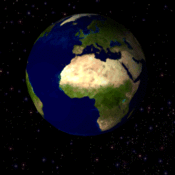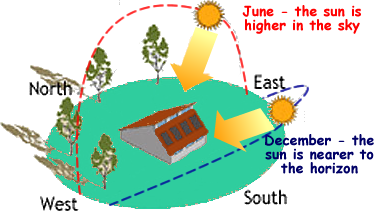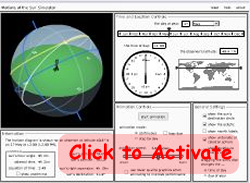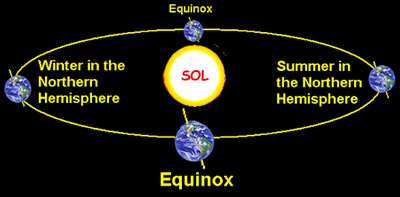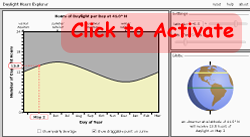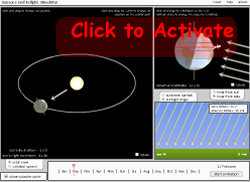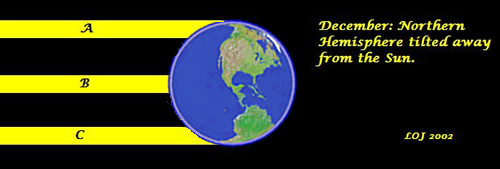The Earth in Space: Day, Year and Seasons
Year Length
How the apparent daily and annual movement of the Sun and other stars is caused by the movement of the earth: Seasons and Day Length Variation.
This difference in daylight time is because the Earth is tilted on its axis as it orbits the Sun. This gives rise to seasons.
In the winter the northern hemisphere is tilted away from the Sun, therefore countries such as ours spend more that half of the time facing away from the Sun (longer nights!). In the summer the northern hemisphere is tilted towards the Sun, therefore countries such as ours spend more that half of the time facing the Sun (longer days!). In September and March the equinox occurs and daylight hours equal night time hours.
Here is an animation that shows the variation in daylight time at different positions on the Earth's surface. You can change the latitude of the area you are interested in. See how very northern and southern latitudes have periods of total darkness and total daylight during the year. I wish I could take the credit for this Flash graphic but I can't. It appears on so many sites it is hard to tell who wrote it! Look carefully at the graphics and you can see how the shadow moves across the Nothern hemisphere of the Earth as the year progresses. In midwinter the Arctic gets no daylight for several days and in the summer the sun never sets for several days! s the Earth moves around the Sun the angle at which the Sun's rays changes. If the Sun's rays hit the surface perpendicularly then the Earth receievs the greatest intensity of rays. The greater the angle they are tilted at the more spread out the rays are and the lower the intensity. That is why the Northern hemisphere countries are hotter in June and cooler in Decemeber - and vice versa in the Southern hemisphere countries The Sun's rays are parallel to each other as they hit the Earth's surface The Earth is such a long way from the Sun that it only intercepts a tiny fragment of the Sun's energy. Most of it goes out into space where our Sun is seen shining as a star. We say that the Sun gives out energy in rays.... the energy radiates from the Sun in all directions. Let us look at some rays coming from a point an consider how they travel relative to one another.
These are obviously going further away from each other... radiating from the point, just as the Sun's rays radiate from its surface. Look at sections of the graphic. very close to the source it is obvious that they are splaying out from a point - but a long way from the source they seem to be spreading out less. The greater the distance this effect is observed over, the more parallel the rays are to each other. As they hit Earth the rays are travelling so parallel to each other you would need very special equipment to show that this wasn't the case. Our Earth is a long way from the Sun. The rays it intercepts are travelling parallel to each other when they hit Earth...

Consider beams of energy from the Sun of equal width (therefore equal energy). Beams A and C hit the Earth near in the polar region... therefore the energy is spread over a much larger area than the rays that hit in the equatorial region. This is one reason why the Equator is warmer than the Poles.... the Sun's enegy is more concentrated at the Equator because it is spread out over a smaller area of the Earth's surface. That is why you need a stronger protection-factor sunscreen when you take your vacation in the tropics rather than in Britain!
In this diagram the Earth is tilted AWAY from the Sun....
The Earth is tilted on its axis. Therefore the length of the daylight time varies throughout the year. In December the UK has short days because the Northern Hemisphere is tilted away from the Sun. In June the opposite is true and in March and September we get equinox (equal day and night - 12h each). The tilt makes the concentration of suns rays hitting a spot on the Earth vary too. In the summer a point in the Northern hemisphere recieves more concentrated rays that in wintertime. The affects the average temperature at that location. How does our planet's tilt affect life on Earth? These variations have an effect on the flora and fauna (plants and animals). They have to develop ways of coping with the change. Hibernating animals and deciduous trees have evolved to cope with the variations in daylight and temperature during the year. Also there is the way that animals moult and grow a summer/winter coat or migrate.... if we had no tilt they would not be needed and our planet would be very different. Each spot on the Earth's surface would have very little variation in average temperature from month to month. A planet with no tilt would have diffeent life cycles that were not linked with orbital periods. |
Follow me...
|


